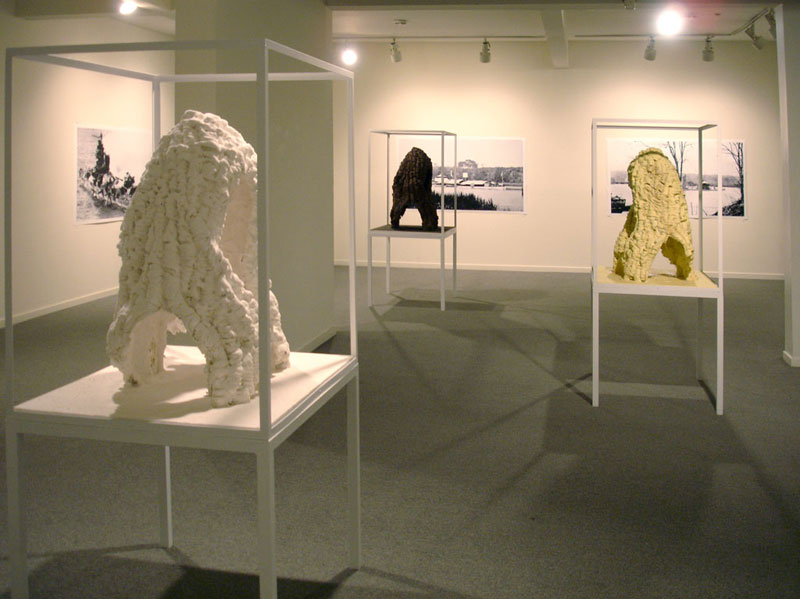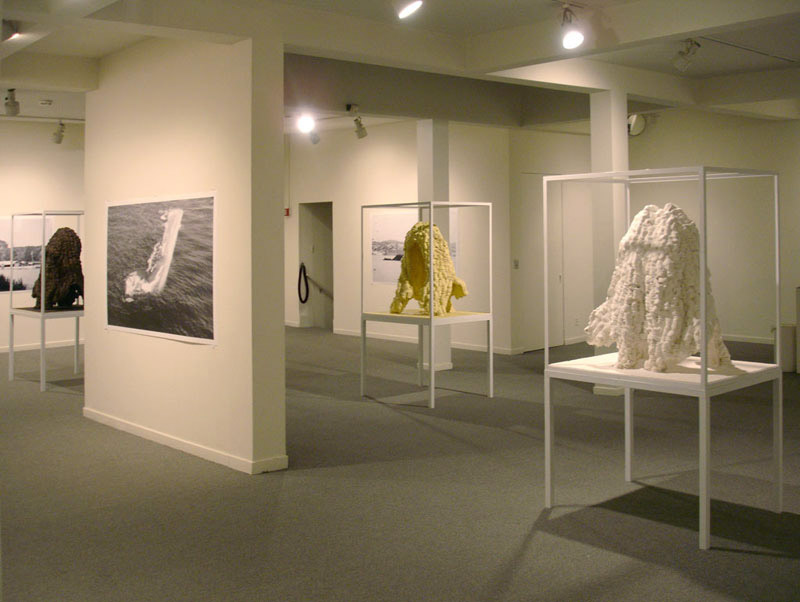| The installation, Thermodynamics
of Silence, is the dominate element in the exhibition, New
Work at Gallery Paule Anglim, which also includes
documentation of recent environmental projects and proposals. Thermodynamics
of Silence presents two linked “natural formations,” one
of sculpture, the other of wall-mounted images. The sculptures, Organic
Logic (Alpine Orogeny), Organic Logic (Tethyian
Realm) and Organic Logic (Hercynian Orogeny) are
made of three animate materials: accreted gypsum, allotropic
sulfur and rusting iron/gypsum, respectively, in the form
of oversize 17th century wigs. The title/material/image
relationship of the sculptures refers to the deep geologic
history of Europe and the 17th and 18th century “Baroque
Project,” a time of systemic synthesis and natural
philosophy, in particular the thinking of the philosopher
W. G. Leibniz, “…who accorded prominence to
categories such as fluidity and elasticity,”(1) and
can be argued, anticipated the inherent vitalism of self-organizing
systems and quantum mechanics in his development of a metaphysical
system based on monads(2).
The seven wall mounted images in Thermodynamics of Silence, are
of American Civil War and WWII ships, from public sources, from the series Orders
of Entropy. This title indicates that the ships are thermo/chemical
or natural/anthropocene(3) structures, in different ‘states’ of
extraction, transformation and dissolution within nature.
The
juxtaposition of these sculptures and images in Thermodynamics
of Silence, is meant to suggest systemic relationships
and responsibilities for materiality, ethics and awareness
of natural systems. The dialectic of the exhibition
is a critique of the history of the mechanistic world
view, its natural laws, systems and presumptuousness,
(which today is still unable to articulate its own
critique [silence]), and of an assertion of a reimagined
organic/romantic, sublime which perceives and empathizes(4) with entropy, chemical/material change and systemic
relationships from the sub-atomic to macro scales.
|
1 Folding
in Architecture, Architectural Design special issue no.
103, edited by Greg Lynn, 1993. Further examples
of the architect, Greg Lynn’s interest in Leibniz’s
work can be found in his book, Animate Form, Princeton
Architectural Press, 1999.
2 Aspects of the work of J. W. Goethe, A. N.
Whitehead and G. Deleuze engage with similar
themes. Also see: Manuel DeLanda’s essay, “Nonorganic
Life,” pg. 128-167, in Incorporations, J. Crary and S.
Kwinter, ed., Zone Books, 1992.
3 The term “anthropocene” (anthrop + holocene) is related
to “anthroturbation,” a term developed in conversation
with the geophysicist, Paul Spudich, that has been an ongoing
theme in my
work:
Cities, architecture, roads and other civic constructions made
by mankind of earth materials during our Epoch (the Holocene)
may be considered
in a geologic context as forms of ‘anthroturbation.’1 This
term describes the disturbance, dislocation and restructuring of geologic
formations and materials by human agencies into new forms. These processes
have analogies in the natural world, such as: mining as erosion, transport
as flow and construction as sedimentation. Likewise, the built topography
of a city can be understood in geomorphic terms: streets as canyons,
buildings as plateaus, sewers as caves and plazas as playas. From the
artist’s statement for Holocene
Terrace, in the solo exhibition, “Morphology of Change,” Lance
Fung Gallery, NY, NY, 1999
4 ”Feeling is the agent that reduces the universe to its perspective
for fact.” Whitehead, A. N., “Importance,” Modes
of Thought, Freepress, 1938/1968, p. 10.
|



